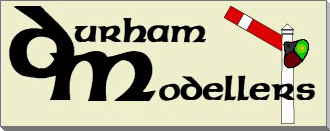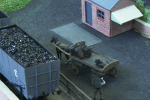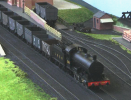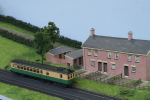Our Layouts
Thorpe Thewles
- Scale - 4mm/ft. 00
- Era - 1923 - 1939
- Number of operators - 3
- Exhibition space required - 24ft. X 11ft. and space to barriers
This represents a small, twin track, country branch line station, with continuous running in 00 code 75. Set in the 1920s and 1930s.
This layout was a departure from tradition for us, being based for the first time on a real location.
Thorpe Thewles was a small country station located on the Stockton and Castle Eden branch of the North East Railway. It was situated about 5 miles north of Stockton-on-Tees and served the local village of the same name. The line was fully open for traffic by 1882.

A scene from the 1930's as a Bachmann LNER K3 heads a local goods through the station.
This track plan shows only the front viewing area of the layout, which is actually continuous running with an 8 road fiddle yard at the rear.

The branch itself was an important part of the railway network, taking pressure off the heavily used routes around the Stockton area. There was never a great potential for passenger revenue, as the communities served were quite small - Thorpe Thewles itself only had a population of about 300. Nevertheless, in the 1920's, the branch was provided with 4 trains a day in each direction between Stockton and Wellfield.
The bulk of traffic was coal, together with materials for the regional industries especially shipbuilding. The line usefully connected Teesside with Sunderland and Tyneside. Hay, livestock and clover were the usual goods cargo handled by the station, and there were coal drops to serve the surrounding community.
Thorpe Thewles closed to passengers on 2nd. November 1931, and closed for goods on 2nd. April 1951. The line was used for through traffic until 1968. The station is now used as a visitor centre for the Castle Eden Walkway and has been partly rebuilt and refurbished in the original style. It does not however appear in LNER condition in its present form - in particular, the porch front has not been recreated and the building has security shutters.
The layout is a model of the station as it was in the immediate post-grouping period. The era portrayed is from 1923 to 1939. Passenger workings include push-pull operations using a G5, as well as a Sentinel railcar. Some main line diversions are also worked. Freight is a mixture of coal and mixed goods. Various cargo is carried on mainly kit-built stock. Locomotives presently include a J39, K3, Q6, G5, Sentinel Railcar and a vaiety of main-line express passenger locos.
The station itself occupied a compact site and was only 437m X 55m in total for all of the track layout. With only a small amount of compression, the scenic part of the layout fits on to three 5ft X 1ft.8in. baseboards. There are 3 fiddle yard modules also 5ft. X 1ft.8in. and 4 corner modules of 2ft.6in. X 1ft.6in. The whole layout including stock, backscene and lights packs away into the back of the car! There is no need for van hire to take this layout to shows.
The scenic baseboards are of open frame construction, the fiddle yard boards have solid tops. Dowel locators provide accurate alignment. The legs fold up underneath the baseboards, and automatically lock into position when the layout is erected. All buildings are made from plywood, faced with embossed plasticard and suitably finished, detailed and weathered. Landscape areas are built up from expanded polystyrene and covered with a variety of scenic materials. The trackwork is 00 Peco code 75 and cab control is provided by Gaugemaster HH feedback controllers.
Thorpe Thewles Local History Group
Durham Modellers are grateful for information provided by members of this group. To find out more about Thorpe Thewles and the parish of Grindon, why not visit their website.
click here to visit Thorpe Thewles Local History Group
Alan Betteney
Alan's book - The Castle Eden Branch of the North East Railway, provided much of the information required to build this layout and is also a good read for those interested in finding out more about the line.
If you have any information about this location, or unpublished photographs, we would love to hear from you.














